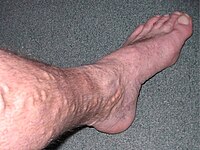
Photo from wikipedia
Background During sclerotherapy, it has been recommended to confirm intravenous placement of the needle by aspirating blood into the sclerosant syringe. This may inactivate some, or all of the sclerosant.… Click to show full abstract
Background During sclerotherapy, it has been recommended to confirm intravenous placement of the needle by aspirating blood into the sclerosant syringe. This may inactivate some, or all of the sclerosant. Aims To quantify the volume of human blood needed to completely inactivate 1 ml of sodium tetradecyl sulphate, and comparing fresh blood and blood that has been stored in an ethylenediaminetetraacetic acid tube. Methods A series of manual titrations were carried out following a procedure developed at STD Pharmaceutical Products Ltd (Hereford, UK) and listed in the British Pharmacopeia. Three percent of sodium tetradecyl sulphate stock solutions were made with increasing volumes of blood and titrated against benzethonium chloride to determine the active concentration (% w/v) of sodium tetradecyl sulphate remaining in the solution. Results A calculated approximation showed 0.3 ml of blood is required to fully inactivate 1 ml of 3% sodium tetradecyl sulphate when made into a foam. A comparison was made between the use of fresh blood and blood stored in ethylenediaminetetraacetic acid tubes. Blood stored in ethylenediaminetetraacetic acid tubes showed more inactivation of sodium tetradecyl sulphate, but this was not significant at the P ≤ 0.05 level. Conclusion The data from our study have shown that a minimum of 0.3 ml of fresh blood is required to inactivate 1 ml of 3% sodium tetradecyl sulphate as a foam and it is not significantly affected by storing blood in an ethylenediaminetetraacetic acid tube. Our methodology suggests that during foam sclerotherapy treatment, blood should not be aspirated into the syringe to confirm position, and that ultrasound guidance is more appropriate for needle placement.
Journal Title: Phlebology
Year Published: 2018
Link to full text (if available)
Share on Social Media: Sign Up to like & get
recommendations!